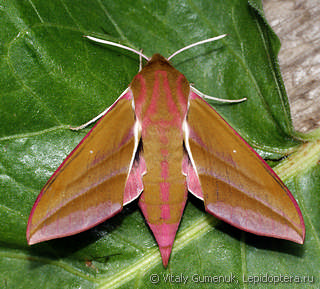Deilephila elpenor

Taxonomy
class Insecta
Species name(s)
Deilephila elpenor (Linnaeus, 1758) = Sphinx elpenor Linnaeus, 1758 = Sphinx porcus Retzius, 1783 = Elpenor vitis Oken, 1815 = Chaerocampa lewisii Butler, 1875 = cinerescens (Newnham, 1900) = clara (Tutt, 1904) = obsoleta (Tutt, 1904) = pallida (Tutt, 1904) = unicolor (Tutt, 1904) = virgata (Tutt, 1904) = vautrini (Austaut, 1907) = daubi (Niepelt, 1908) = hades (Rebel, 1910) = alboradiata (Lambillion, 1913) = philipsi Niepelt, 1921 = scheiderbaueri (Gschwandner, 1924) = lugens (Niepelt, 1926) = argentea Burrau, 1950 = szechuana (Chu & Wang, 1980) = tristis Lempke & Stolk, 1986. [9, 10]
Elephant Hawk-moth.
urn:lsid:insecta.pro:taxonomy:2820
Expansion
This species marks on the maps: 13.
Zoogeographical regions
Palaearctic.
Russia regions
#1. Kaliningradsky; #3. Karelsky; #4. Evropeisky Severo-Zapadny; #7. Evropeisky yuzhno-tayozhny; #8. Evropeisky Tsentralny; #9. Evropeisky Tsentralno-Chernozyomny; #10. Sredne-Volzhsky; #11. Volgo-Donsky; #12. Nizhnevolzhsky; #13. Zapadno-Kavkazsky; #14. Vostochno-Kavkazsky*; #16. Sredne-Uralsky; #17. Yuzhno-Uralsky; #20. Yuzhno-Zapadnosibirsky; #22. Krasnoyarsky; #23. Predaltaisky; #24. Gorno-Altaisky*; #27. Pribaikalsky; #28. Zabaikalsky; #31. Yuzhno-Yakutsky; #36. Sredne-Amursky; #37. Nizhne-Amursky; #38. Sakhalin; #39. Yuzhno-Kurilsky; #40. Primorsky.
* An asterisk denotes a region for which the species is listed as an migrant or information that requires additional checking.
Forewing length
27—37 mm.
Wingspan
55—60 mm.
Primary colors
Red, Yellow, Green, Brown/Gray/Black.
Flight time
| January | February | March | April | May | June | July | August | September | October | November | December |
Larva lifespan
| January | February | March | April | May | June | July | August | September | October | November | December |
Over-wintering stage
Pupa.

Detailed information with references
Distribution
Imago Habitus and Differences from alike species
General info about Imago
Imago lifespan
General info about Larva
Larva food plants / other food objects
Larva lifespan
Egg
Overwintering stage
Subspecies of Deilephila elpenor
- Deilephila elpenor elpenor (Linnaeus, 1758). [10]
- D. e. lewisi Butler, 1875. [187]
- D. e. macromera (Butler, 1875). [9]
- D. e. szechuana Chu & Wang, 1980. [187]
Authors
Initial species uploading to the site: Peter Khramov.
Text data: Peter Khramov.
The species characteristics formalization: Peter Khramov, Sergei Kotov.
References
- [1] O. Karsholt, J. Razowski (eds.), 1996. The Lepidoptera of Europe: a distributional checklist
- [3] Каталог чешуекрылых (Lepidoptera) России. Под ред. С. Ю. Синёва. СПб.; М.: Товарищество научных изданий КМК, 2008
- [5] Райххолф-Рим Х. Бабочки. М.: Астрель, 2002
- [9] Tree of Life (funet.fi), 2012
- [10] de Jong, Y.S.D.M. (ed.) (2011) Fauna Europaea version 2.4 (faunaeur.org)
- [28] Moths and Butterflies of Europe and North Africa (leps.it), 2012
- [187] Species 2000, http://www.sp2000.org
Comments
Note: you should have a Insecta.pro account to upload new topics and comments. Please, create an account or log in to add comments
Deilephila elpenor photos
























































































All the photos of the species in large size
Please, create an account or log in to upload your photo


